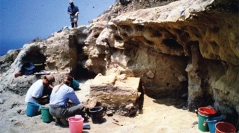

 Anthropozoologica
50 (2) - Pages 123-150
Anthropozoologica
50 (2) - Pages 123-150This paper aims to identify a series of conceptual, strategic and technological challenges facing archaeozoology (and archaeobotany) in order to better understand when, where, how and why plant and animal domestication and farming developed during the last 12 000 years. Situated at the interface of human societies and their environment, this reflection is based on examples, some of them unpublished, and on many references to animal domestication and husbandry in Eurasia, especially in East Asia, Southwest Asia and Cyprus. From a conceptual point of view, the author calls for an integrative systemic approach within the structural framework of the anthroposystem – a metasystem grouping societies and their environments, namely, their biodiversity. In order to tackle the full complexity of the system, equal attention must be paid to the biological, evolutionary and ecological components, as well as to the anthropological dynamics of human societies including technical, social and cultural aspects. To facilitate such an approach, this paper proposes a series of dynamic lines of research in order to explore the numerous gaps in our understanding of the beginnings of domestication and of the Neolithic transition, covering both causal factors and the diverse strategies developed by past societies. It pays special attention to the increasingly varied and cutting-edge technologies that can be used within these research projects, specifically quantitative data processing and databasing, direct radiocarbon dating of the bioarchaeological remains, traditional or geometric morphometrics, paleogenetics and paleogenomics, and sequential analyses of stable isotope ratios. More generally speaking, this paper aims to contribute to the development of an emerging and very promising interdisciplinary field of research.
Domestication, Neolithic transition, archaeozoology, archaeobotany, Southwest Asia, Cyprus, China, research strategy